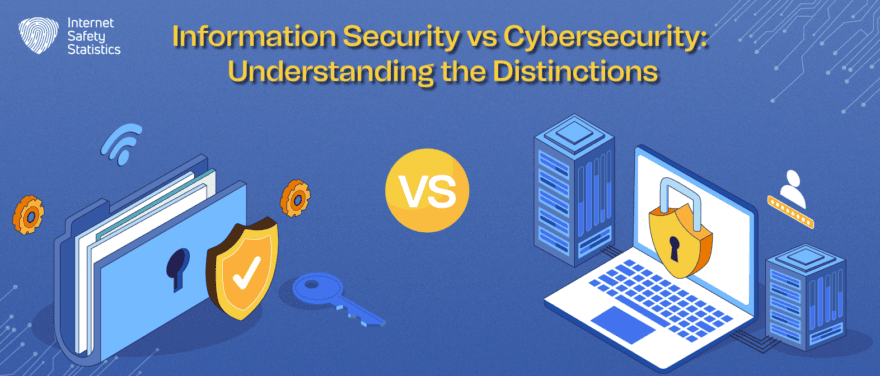
The digital landscape, with its vast networks and intricate systems, presents a dynamic battleground where organisations strive to protect their valuable assets from an array of threats. Often, terms like “information security vs cybersecurity” are used synonymously, creating a misconception that they are one and the same.
This article embarks on a journey to untangle the intricacies of these terms, elucidating the unique responsibilities and focus areas of information security and cybersecurity. By unravelling these distinctions, we aim to empower businesses and individuals to fortify their defences in the face of evolving digital risks.
Understanding Information Security

Information Security, often referred to as InfoSec, encompasses the practice of protecting sensitive information from unauthorised access, disclosure, disruption, modification, or destruction. It is a multidisciplinary field that addresses the confidentiality, integrity, and availability of data, aiming to ensure that information assets remain secure against a variety of threats.
Key Components
In Information Security, several key components form the pillars of a robust defence. These key components include:
- Data Protection: Data protection is at the core of Information Security. It involves implementing measures to safeguard data throughout its lifecycle, encompassing encryption, secure storage, and secure transmission. The goal is to prevent unauthorised access or leakage of sensitive information.
- Access Controls: Access controls define and regulate who can access specific resources within a system. This involves the use of authentication methods such as passwords, biometrics, or multi-factor authentication to verify the identity of users. Authorisation mechanisms then determine the level of access granted based on user roles and responsibilities.
- Identity Management: Identity management focuses on establishing and managing the identities of individuals within a system. This includes user provisioning, de-provisioning, and ensuring that access privileges align with the principle of least privilege. Effective identity management is crucial for preventing unauthorised access and ensuring accountability.
- Security Policies and Procedures: Security policies and procedures form the foundation of Information Security governance. These documents outline rules, guidelines, and best practices for protecting information assets. They cover areas such as acceptable use policies, incident response plans, and data classification, providing a framework for organisations to establish a robust security posture.
Examples of Information Security Measures
- Firewalls and Intrusion Prevention Systems (IPS): These technologies act as the first line of defence, monitoring and controlling incoming and outgoing network traffic based on predetermined security rules. Firewalls and IPS help prevent unauthorised access and protect against cyber threats.
- Encryption: Encryption transforms sensitive data into an unreadable format, ensuring that even if unauthorised individuals gain access, the information remains indecipherable. This is crucial for protecting data both in transit and at rest.
- Antivirus Software: Antivirus software detects, prevents, and removes malicious software (malware) from computer systems. It plays a vital role in safeguarding against viruses, trojans, and other forms of malware that could compromise data integrity and system functionality.
- Employee Training and Awareness Programs: Human error is a significant threat to information security. Training programs educate employees about security best practices, social engineering threats, and the importance of data confidentiality. Well-informed employees contribute to a more resilient security environment.
In essence, Information Security is a holistic approach to safeguarding digital assets, encompassing a combination of technological, procedural, and human-centric measures to create a robust defence against evolving cyber threats.
Exploring Cybersecurity
Cybersecurity is a comprehensive discipline dedicated to safeguarding digital systems, networks, and data from cyber threats, ensuring their confidentiality, integrity, and availability. Distinct from the broader concept of information security, cybersecurity specifically focuses on defending against threats emanating from the digital realm, including malicious cyber activities and unauthorised access.
Core Components
The synergy of various components is essential to form a resilient defence against a spectrum of cyber threats. These core components, encompassing network security, endpoint security, application security, and cloud security, collectively create a robust framework that addresses vulnerabilities, mitigates risks, and ensures the integrity of digital ecosystems.
- Network Security: Network security is a fundamental element of cybersecurity that involves implementing measures to protect the integrity and confidentiality of data during transmission. This includes firewalls, intrusion detection systems, and virtual private networks (VPNs) to secure network boundaries and monitor traffic for suspicious activities.
- Endpoint Security: Endpoint security revolves around securing individual devices such as computers, laptops, and mobile devices that connect to a network. Antivirus software, encryption, and intrusion prevention systems are vital components, safeguarding endpoints from malware, unauthorised access, and other cyber threats.
- Application Security: Application security focuses on protecting software and applications from vulnerabilities that could be exploited by cyber attackers. Secure coding practices, regular software updates, and penetration testing are integral to mitigating risks and ensuring that applications do not become entry points for unauthorised access.
- Cloud Security: Cloud security addresses the unique challenges associated with cloud computing environments. It encompasses measures to secure data stored in the cloud, control access to cloud resources, and ensure the integrity of cloud-based applications. Encryption, identity and access management, and regular audits are crucial for effective cloud security.
Real-World Applications of Cybersecurity Practices
In practice, cybersecurity principles manifest in diverse sectors, adapting to the unique challenges of each industry.
- Financial Institutions: In the financial sector, cybersecurity practices are paramount to protect sensitive customer information, financial transactions, and critical infrastructure. Secure online banking platforms, encryption of financial data, and robust firewalls are essential components of cybersecurity strategies.
- Healthcare Industry: The healthcare industry relies on cybersecurity to safeguard patient records, medical devices, and sensitive research data. Measures such as access controls, encryption of electronic health records (EHR), and regular security audits are crucial to ensure patient confidentiality and compliance with regulations.
- Government Agencies: Governments worldwide leverage cybersecurity practices to protect national security, critical infrastructure, and sensitive information. This includes securing communication networks, implementing robust endpoint security measures, and monitoring for cyber threats to prevent espionage or disruption.
- E-commerce Platforms: E-commerce platforms heavily depend on cybersecurity to secure online transactions, customer data, and payment gateways. SSL/TLS encryption, secure authentication processes, and continuous monitoring for fraudulent activities contribute to a secure online shopping environment.
Comparative Analysis: Information Security vs Cybersecurity

Information Security and Cybersecurity, while distinct, share common ground in safeguarding digital assets. Both disciplines are crucial in preserving the confidentiality, integrity, and availability of data, aligning their objectives to fortify against unauthorized access, data breaches, and cyber threats.
| Aspect | Information Security | Cybersecurity |
|---|---|---|
| Overlapping Areas | Importance of Both Disciplines | Shared Objectives |
| Unique Focus of Information Security | Emphasis on Data Integrity and Confidentiality | Compliance and Legal Aspects |
| Unique Focus of Cybersecurity | Proactive Threat Mitigation | Incident Response and Recovery |
In Information Security, the emphasis lies in preserving data integrity and confidentiality while addressing compliance and legal considerations. On the other hand, Cybersecurity takes a proactive stance, focusing on anticipating and mitigating threats, coupled with robust incident response and recovery strategies. Together, these disciplines form a comprehensive defence against the dynamic landscape of cyber threats.
Challenges and Trends in Information Security and Cybersecurity
Keeping digital information safe faces hurdles like clever hackers, human errors, and constantly changing tactics. It’s a bit like building an ever-changing fortress to protect important data. Staying one step ahead of potential risks and understanding new types of threats can be tough.
In the world of digital protection, trends are like the latest tools and strategies. More businesses are focusing on keeping their defences strong. Using smart tech like artificial intelligence and paying close attention to how employees interact with data are some cool trends. It’s like upgrading shields and adapting to the latest tricks that cyber guardians use.
How to Strengthen Your Digital Defence: A Practical Guide for Businesses
Navigating the dynamic world of digital risks demands a savvy strategy to shield your business from cyber threats. It’s about marrying the strengths of both Cybersecurity and Information Security in a proactive manner. Let’s dive into a hands-on guide on effectively putting these essential measures into action.
Aligning Security Measures with Organisational Goals
Start by aligning your security measures with the goals of your organisation. Identify the key assets and information that are critical to your business operations. Whether it’s customer data, proprietary software, or financial records, understanding what needs protection allows you to tailor your security strategies accordingly. By aligning security efforts with your specific objectives, you ensure that resources are focused where they matter most.
Resource Allocation and Budget Considerations
Security is an investment, and like any investment, it requires careful planning. Allocate resources based on the identified risks and priorities. This might involve investing in robust antivirus software, employee training programs, or the latest encryption technologies. Consider the balance between preventive measures and incident response capabilities. A well-thought-out budget ensures that you have the necessary tools and strategies in place without unnecessary expenses.
Case Studies: Successes and Failures
Learning from the experiences of others is a valuable part of the process. Explore case studies that highlight both successes and failures in the realm of cybersecurity. Understand how businesses with similar profiles navigated challenges and what strategies led to their success.
Equally important is learning from failures—identifying where security measures fell short and the consequences that ensued. These case studies provide practical insights that can inform your own security strategies.
Employee Training and Awareness Programs
Human error is a significant factor in security breaches. Invest in training programs that raise awareness among your employees. Educate them on best practices, potential threats, and the importance of adhering to security policies. Creating a security-conscious culture within your organization is a powerful defence against social engineering attacks and inadvertent data breaches.
Regular Security Audits and Updates
Security is not a one-time task; it’s an ongoing process. Conduct regular security audits to assess the effectiveness of your measures. Stay vigilant for emerging threats and update your security protocols accordingly. Regular software updates, patch management, and continuous monitoring are crucial to staying resilient in the face of ever-evolving cyber risks.
By following these practical steps, businesses can create a robust defence against cyber threats, blending the strengths of both Cybersecurity and Information Security. Remember, it’s not just about building walls; it’s about creating a dynamic and adaptive fortress that grows with the evolving digital landscape.
As we wrap up our exploration of cybersecurity and information security, it’s clear that the digital landscape demands a comprehensive and dynamic defence strategy. By aligning goals, allocating resources strategically, and incorporating the lessons learned from both successes and failures, businesses can create a robust security framework. Remember, it’s not just about protecting data; it’s about safeguarding the trust and confidence of your stakeholders. As you move forward, may your digital journey be secure and your defences resilient in the face of evolving challenges.
